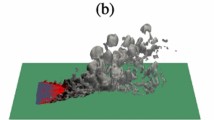Abstract
Among the modelling approaches that have been proposed for the simulation of wildfire propagation, two have gained considerable attention in recent years: the one based on a reaction-diffusion equation, and the one based on the level set method. These two approaches, traditionally seen in competition, do actually lead to similar equation models when the level set method is modified taking into account random effects as those due to turbulent hot air transport and fire spotting phenomena. The connection between these two approaches is here discussed and the application of the modified level set method to test cases of practical interest is shown.



Similar content being viewed by others
References
Sullivan, A.: A review of wildland fire spread modelling, 1990-present, 1: physical and quasi-physical models. Int. J. Wildland Fire 18, 349–368 (2009)
Sullivan, A.: A review of wildland fire spread modelling, 1990-present, 2: empirical and quasi-empirical models. Int. J. Wildland Fire 18, 369–386 (2009)
Sullivan, A.: Wildland surface fire spread modelling, 1990–2007. 3: Simulation and mathematical analogue models. Int. J. Wildland Fire 18, 387–403 (2009)
Asensio, M.I., Ferragut, L.: On a wildland fire model with radiation. Int. J. Numer. Meth. Eng. 54, 137–157 (2002)
Mandel, J., Bennethum, L.S., Beezley, J.D., Coen, J.L., Douglas, C.C., Kim, M., Vodacek, A.: A wildland fire model with data assimilation. Math. Comput. Simulat. 79, 584–606 (2008)
Babak, P., Bourlioux, A., Hillen, T.: The effect of wind on the propagation of an idealized forest fire. SIAM J. Appl. Math. 70, 1364–1388 (2009)
Sethian, J.A., Smereka, P.: Level set methods for fluid interfaces. Ann. Rev. Fluid Mech. 35, 341–372 (2003)
Mallet, V., Keyes, D.E., Fendell, F.E.: Modeling wildland fire propagation with level set methods. Comput. Math. Appl. 57, 1089–1101 (2009)
Rehm, R.G., McDermott, R.J.: Fire-front propagation using the level set method. Tech. Note 1611, Natl. Inst. Stand. Technol. (2009)
Pagnini, G., Massidda, L.: The randomized level set method to model turbulence effects in wildland fire propagation. In: Proc. of the Int. Conf. on Fire Behaviour and Risk (ICFBR2011), 126–131 (2012)
Pagnini, G., Massidda, L.: Modelling turbulence effects in wildland fire propagation by the randomized level set method. CRS4 Technical Report 2012/PM12a, July 2012. Revised Version August 2014. http://publications.crs4.it/pubdocs/2012/PM12a/pagnini_massidda-levelset (2014)
Filippi, J.B., Bosseur, F., Mari, C., Lac, C., Moigne, P.L., Cuenot, B., Veynante, D., Cariolle, D., Balbi, J.H.: Coupled atmosphere-wildland fire modelling. J. Adv. Model. Earth Syst. 1, 1–9 (2009)
Mandel, J., Beezley, J.D., Kochanski, A.K.: Coupled atmosphere-wildland fire modeling with WRF 3.3 and SFIRE 2011. Geosci. Model Dev 4, 591–610 (2011)
Potter, B.E.: Atmospheric interactions with wildland fire behaviour—I. basic surface interactions, vertical profiles and synoptic structures. Int. J. Wildland Fire 21, 779–801 (2012)
Potter, B.E.: Atmospheric interactions with wildland fire behaviour—II. plume and vortex dynamics. Int. J. Wildland Fire 21, 802–817 (2012)
Sardoy, N., Consalvi, J.L., Porterie, B., Fernandez-Pello, A.C.: Modeling transport and combustion of firebrands from burning trees. Combust. Flame 150, 151–169 (2007)
Perryman, H.A.: A mathematical model of spot fires and their management implications. Master’s thesis, Humboldt State University, Arcata (2009). http://hdl.handle.net/2148/551
Sardoy, N., Consalvi, J.L., Kaiss, A., Fernandez-Pello, A.C., Porterie, B.: Numerical study of ground-level distribution of firebrands generated by line fires. Combust. Flame 154, 478–488 (2008)
Boychuk, D., Braun, W.J., Kulperger, R.J., Krougly, Z.L., Stanford, D.A.: A stochastic forest fire growth model. Environ. Ecol. Stat. 16, 133–151 (2009)
Pagnini, G., Mentrelli, A.: Modelling wildland fire propagation by tracking random fronts. Nat. Hazards Earth Syst. Sci. 14, 2249–2263 (2014)
Kaur, I., Mentrelli, A., Bosseur, F., Filippi, J.-B., Pagnini, G.: Wildland fire propagation modelling: a novel approach reconciling models based on moving interface methods and on reaction-diffusion equations. In: Proceedings of the International Conference Applications of Mathematics 2015 (Prague, CZ; November 18–21, 2015); Eds. J. Brandts et al.; Institute of Mathematics AS CR, Prague, 85–99 (2015)
Kaur, I., Mentrelli, A., Bosseur, F., Filippi J.B., Pagnini, G.: Turbulence and fire-spotting effects into wild-land fire simulators. Commun. Nonlinear Sci. Numer. Simul. (2016, in press). doi: 10.1016/j.cnsns.2016.03.003
Montenegro, R., Plaza, A., Ferragut, L., Asensio, M.I.: Application of a nonlinear evolution model to fire propagation. Nonlinear Anal. Theory Methods Appl. 30, 2873–2882 (1997)
Serón, F.J., Gutiérrez, D., Magallón, J., Ferragut, L., Asensio, M.I.: The evolution of a wildland forest fire front. Visual Comput. 21, 152–169 (2005)
Rothermel, R.C.: A mathematical model for predicting fire spread in wildland fires. Tech. Rep. Research Paper INT-115, USDA Forest Service, Intermountain Forest and Range Experiment Station, Ogden, Utah 84401 (1972)
Finney, M.: Calculation of fire spread rates across random landscapes. Int. J. Wildland Fire 12, 167–174 (2003)
Balbi, J.H., Morandini, F., Silvani, X., Filippi, J.B., Rinieri, F.: A physical model for wildland fires. Combust. Flame 156, 2217–2230 (2009)
Klimontovich, Y.L.: Nonlinear Brownian motion. Phys.-Uspekh. 37, 737–767 (1994)
Pagnini, G., Bonomi, E.: Lagrangian formulation of turbulent premixed combustion. Phys. Rev. Lett. 107, 044503 (2011)
Dafermos, C.M.: Continuous solutions for balance laws. Ric. Mat. 55, 79–91 (2006)
De Angelis, M., Renno, P.: Existence, uniqueness and a priori estimates for a nonlinear integro-differential equation. Ric. Mat. 57, 95–109 (2008)
Mentrelli, A., Pagnini, G.: Random front propagation in fractional diffusive systems. Commun. Appl. Ind. Math 6(2), e-504 (2014)
Mentrelli, A., Pagnini, G.: Front propagation in anomalous diffusive media governed by time-fractional diffusion. J. Comput. Phys. 293, 427–441 (2015)
Byram, G.M.: Combustion of forest fuels. In: Davis, K.P. (ed.) Forest Fire: Control and Use, pp. 61–89. McGraw Hill, New York (1959)
Acknowledgments
This research was supported by GNFM/INdAM Young Researchers Project 2015 ‘An Eulerian/Lagrangian model for combustion fronts’, by MINECO under Grant MTM2013-40824-P, by Bizkaia Talent and European Commission through COFUND programme under Grant AYD-000-226, by the Basque Government through the BERC 2014-2017 program, and by the Spanish Ministry of Economy and Competitiveness MINECO: BCAM Severo Ochoa accreditation SEV-2013-0323.
Author information
Authors and Affiliations
Corresponding author
Rights and permissions
About this article
Cite this article
Mentrelli, A., Pagnini, G. Modelling and simulation of wildland fire in the framework of the level set method. Ricerche mat 65, 523–533 (2016). https://doi.org/10.1007/s11587-016-0272-1
Received:
Revised:
Published:
Issue Date:
DOI: https://doi.org/10.1007/s11587-016-0272-1




